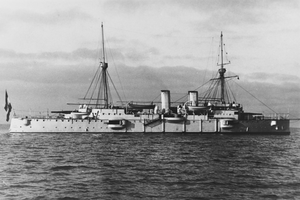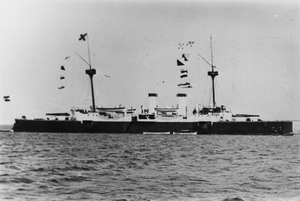Kaiser Franz Joseph I-class cruiser
Constructed in response to the Italian cruisers Giovanni Bausan and Etna, the design of the Kaiser Franz Joseph I class was heavily influenced by the Jeune École (Young School) naval strategy.
Kaiserin Elisabeth saw action during the Boxer Rebellion, and thereafter the two ships of the Kaiser Franz Joseph I class would alternate tours of duty in the Far East until the start of World War I.
When Austria-Hungary was facing defeat in October 1918, the Austrian government transferred its navy to the newly formed State of Slovenes, Croats and Serbs in order to avoid having to hand the ship over to the Allies.
Following the Armistice of Villa Giusti in November 1918, an Allied fleet sailed into Cattaro and seized the former Austro-Hungarian ships stationed in the Bocche, including Kaiser Franz Joseph I.
On 13 November 1883, Emperor Franz Joseph I promoted Maximilian Daublebsky von Sterneck to the office of vice admiral, and named him Marinekommandant of the Austro-Hungarian Navy as well as Chief of the Naval Section of the War Ministry (German: Chef der Marinesektion).
[5] His strong support for Jeune École was rooted in a belief that the strategy appeared to fit existing Austro-Hungarian naval policy, which stressed coastal defense and limited power projection beyond the Adriatic Sea.
Tests conducted by the Austro-Hungarian Navy during the early and mid 1880s led Sterneck to believe that torpedo boat attacks against a fleet of battleships, a central component of Jeune École, would have to be supported by larger ships such as cruisers.
These tests, as well as the adoption of Jeune École as the principal naval strategy of the Austro-Hungarian Navy, led to the development of the Kaiser Franz Joseph I-class cruisers.
[7] Authorized near the start of Austria-Hungary's second naval arms race against Italy, the Kaiser Franz Joseph I-class cruisers were designed to lead torpedo flotillas into battle against a larger fleet of battleships.
Sterneck also believed that the cruisers would operate in chaotic melee engagements alongside the torpedo division they would lead, which would necessitate a bow ram in order to damage and sink enemy vessels similar to what Tegetthoff had done at Lissa.
The large guns of the cruisers were also chosen in order to give credence to Sterneck's plan for the Kaiser Franz Joseph I-class ships to replace heavily armored ironclads and battleships.
[1][17] The machinery for the Kaiser Franz Joseph I class was assembled at Stabilimento Tecnico Triestino, and both ships were constructed with a double-bottom hull and designed with over 100 watertight compartments.
The fiber was intended to seal up any holes in the ships from artillery rounds by swelling up upon contact with seawater, while the impacting shell itself would be slowed down by the surrounding coal, which would also serve to contain any explosions.
Sterneck continued to support the concept of torpedo ram cruisers rest of his tenure as Marinekommandant, but his death in December 1897 marked the end of Austria-Hungary's application of Jeune Ecole.
While under the command of Rear Admiral Johann von Hinke, Kaiser Franz Joseph I visited Gibraltar and Cowes in the United Kingdom, where Queen Victoria reviewed the Austro-Hungarian fleet.
Commanded by Captain Alois von Becker and a host of officers which included Archduke Leopold Ferdinand of Austria, Kaiserin Elisabeth sailed through the Adriatic Sea and the Eastern Mediterranean before entering the Suez Canal.
The trip continued from Sydney through Nouméa, New Hebrides, the Solomon Islands, New Guinea, Sarawak, Hong Kong and finally Japan, where Kaiserin Elisabeth and Franz Ferdinand departed ways.
He then traveled through North America by train before crossing the Atlantic Ocean aboard a French steamship, and arrived back in Trieste from Le Havre in October 1893, completing a circumnavigation of the world.
In 1899, Kaiserin Elisabeth conducted her second voyage to the Far East, and the third such trip of the Kaiser Franz Joseph I-class, as part of Austria-Hungary's contributions to putting down the Boxer Rebellion in China.
[31] In 1908, both ships were re-classified as 2nd class cruisers as Kaiserin Elisabeth and Kaiser Franz Joseph I rotated duties, with the former being sent back to China and the later being transferred to Austria-Hungary to serve as a training vessel.
While relations between Austria-Hungary and Italy had improved greatly in the two years following the 1912 renewal of the Triple Alliance,[35] increased Austro-Hungarian naval spending, political disputes over influence in Albania, and Italian concerns over the potential annexation of land in the Kingdom of Montenegro caused the relationship between the two allies to falter in the months leading up to the war.
[38][39] At the start of the war, Kaiser Franz Joseph I was assigned to the Fifth Battle Division, alongside the three Monarch-class coastal defense ships, and the cruiser Panther at the Austro-Hungarian naval base at Cattaro.
[40] After the loss of the cruiser Zenta at the Battle of Antivari, Austro-Hungarian Marinekommandant Anton Haus blamed Barry for failing to intercept the French forces and relieved him of command in October 1914, replacing him with Rear Admiral Alexander Hansa.
[41] Kaiser Franz Joseph I served as a harbor defense ship for most of the remainder of the war,[11] though she did see action against Montenegrin batteries atop Mount Lovćen, which overshadowed the Bocche di Cattaro, where she was stationed.
[42] Kaiserin Elisabeth was to be the only Austro-Hungarian warship caught outside of the Adriatic at the onset of the war, save the yacht Taurus, which managed to evade contact with the Allies during her voyage back to Austria-Hungary from Constantinople.
[40] As she was too slow to conduct commerce raiding operations in the Pacific against British and French shipping, she sailed for the German-held Jiaozhou Bay Leased Territory, before making port at Qingdao where she reinforced Germany's East Asia Squadron.
[54] The following day, many of the mutinous ships abandoned the effort and rejoined loyalist forces in the inner harbor after shore batteries loyal to the Austro-Hungarian government opened fire on the rebel-held Kronprinz Erzherzog Rudolf.
[60] Emperor Karl I, still attempting to save the Empire from collapse, agreed to the transfer, provided that the other "nations" which made up Austria-Hungary would be able to claim their fair share of the value of the fleet at a later time.
The transfer to the State of Slovenes, Croats and Serbs began on the morning of 31 October, with Horthy meeting representatives from the South Slav nationalities aboard his flagship, Viribus Unitis in Pola.
[63] Control over the battleship, and the head of the newly-established navy for the State of Slovenes, Croats and Serbs, fell to Captain Janko Vuković, who was raised to the rank of admiral and took over Horthy's old responsibilities as Commander-in-Chief of the Fleet.










